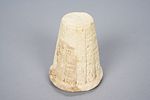Cuneiform Tablet
About this object
History of use
The inscription records the rebuilding of the major temple in the city of Lagash, in ancient Mesopotamia, by the ruler of the city - Gudea, Governor of Lagash. Translation: "For Ningirsu, Enlil's mighty warrior, Gudea, ruler of Lagash, made things function as they should [and] he built and restored for him his Eninnu, the White Thunderbird." M4.19 and M4.24 are two examples of the same inscribed object. Cones were initially plain and put into temple walls for decoration. Cones with inscriptions were intended to be inserted into the corners of mud-brick walls of buildings to, e.g., commemorate who had the temple built, or record the construction (or reconstruction) of a major building.
Narrative
Gudea was a ruler (ensi) of the city of Lagash in Southern Mesopotamia who ruled c. 2144 - 2124 BC. He probably did not come from the city, but had married Ninalla, daughter of the ruler Urbaba (2164 - 2144 BC) of Lagash, thus gaining entrance to the royal house of Lagash.
